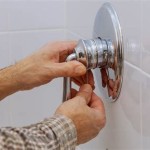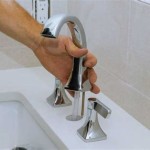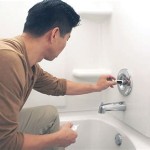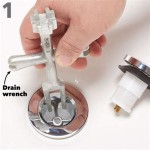Porcelain Enameled Steel Bathtub Vs Cast Iron Sink: A Comparative Analysis
The world of plumbing fixtures offers a vast array of materials and construction techniques, each designed to meet different needs and preferences. Porcelain enameled steel bathtubs and cast iron sinks represent two common choices, each with its inherent advantages and disadvantages. Understanding the properties of each material, along with their respective strengths and weaknesses, is crucial when making informed decisions regarding bathroom and kitchen renovations or new construction projects.
This article aims to provide a detailed comparison between porcelain enameled steel bathtubs and cast iron sinks. It will analyze their composition, manufacturing processes, durability, heat retention, weight, cost, installation requirements, and maintenance needs. By exploring these critical aspects, it will allow readers to evaluate which material best suits their specific requirements and budget.
Porcelain enamel, in both cases, involves fusing a layer of glass-like material onto a base metal. This creates a hard, durable, and non-porous surface that is resistant to scratches, stains, and chemical damage. While the superficial similarity in the finish might suggest equivalent performance, the underlying base material significantly impacts the overall properties and suitability of each fixture.
Understanding Material Composition and Manufacturing
Porcelain enameled steel bathtubs are constructed from a thin sheet of stamped steel, typically around 14-16 gauge, onto which the porcelain enamel is applied. The steel provides the structural support, while the enamel provides the aesthetic appeal, hygiene, and resistance to corrosion. The manufacturing process involves shaping the steel sheet into the desired bathtub form, followed by the application of multiple layers of porcelain enamel. Each layer is then fired at high temperatures to fuse it to the steel substrate.
Cast iron sinks, on the other hand, are made from molten iron poured into a mold, creating a solid, heavy structure. Once the iron cools and solidifies, the mold is removed, and the casting is cleaned and prepared for the application of the porcelain enamel. Similar to the bathtub manufacturing process, multiple layers of enamel are applied and fired to create a robust and durable finish. The inherent density and thickness of cast iron contribute significantly to its weight and thermal properties.
The difference in the base material is fundamental to understanding the distinct performance characteristics of each fixture. Steel, being lighter and more flexible, can be formed into more complex shapes but lacks the inherent thermal mass of cast iron. Cast iron, while heavier and less flexible, provides superior heat retention and sound dampening.
Durability and Resistance to Damage
Both porcelain enameled steel bathtubs and cast iron sinks offer good resistance to general wear and tear when properly maintained. The porcelain enamel surface is resistant to scratches from everyday use, as well as staining from common household substances. However, the underlying material's inherent properties play a significant role in determining the fixture's long-term durability.
Porcelain enameled steel bathtubs are more susceptible to chipping and damage from impacts than cast iron sinks. The thin steel base is prone to denting if a heavy object is dropped into the tub, and the enamel coating can chip if the dent is significant. Once the enamel is chipped, the exposed steel is vulnerable to rust and corrosion. Repairs are possible, but color matching and achieving a seamless finish can be challenging.
Cast iron sinks are significantly more resistant to chipping and denting due to the inherent strength and thickness of the cast iron base. While the enamel coating can still chip under extreme impact, the underlying iron is much less likely to be damaged. This makes cast iron sinks a more durable option for high-traffic kitchens or areas where there is a higher risk of accidental impacts. Even if the enamel chips, the cast iron is less prone to rapid corrosion than exposed steel, offering a longer lifespan.
In terms of chemical resistance, both materials perform well against common household cleaners and detergents. However, abrasive cleaners should be avoided as they can dull the enamel surface over time. The choice of cleaning products should always be carefully considered to preserve the finish and longevity of both types of fixtures.
Weight, Installation and Structural Considerations
A significant difference between porcelain enameled steel bathtubs and cast iron sinks lies in their weight. Steel bathtubs are considerably lighter, typically weighing between 75 to 150 pounds. This makes them easier to maneuver and install, potentially reducing labor costs and simplifying renovations in upper-floor bathrooms. The lighter weight also minimizes the structural demands on the floor joists.
Cast iron sinks are exceptionally heavy, often weighing between 200 to 400 pounds or even more, depending on the size and style. This substantial weight presents considerable challenges during installation. It typically requires two or more people to safely lift and position the sink, and it may necessitate reinforcing the floor joists to adequately support the additional load. This is particularly important in older homes or buildings with weaker structural support.
The installation process for steel bathtubs is generally straightforward, often involving shimming the tub to ensure it is level and securing it to the wall studs. The lighter weight makes it easier to adjust and fine-tune the positioning. However, proper support underneath the tub is still crucial to prevent flexing and potential damage to the enamel coating.
Installing a cast iron sink is a more complex and demanding task. The weight necessitates careful planning and the use of appropriate lifting equipment. The sink must be securely mounted to the countertop or cabinetry, and the floor must be able to bear the load without deflecting. In some cases, professional installation is highly recommended to ensure proper support and prevent future structural issues. Undermount cast iron sinks present additional challenges due to the need for precise cutouts and secure mounting to the countertop material.
The weight difference also impacts transportation costs. Steel bathtubs are typically less expensive to ship due to their lower weight and smaller size, while cast iron sinks can incur higher shipping charges due to their bulky nature and substantial weight.
Heat Retention and Sound Dampening
Heat retention is a crucial factor to consider for bathtubs, as it directly impacts the bathing experience. Cast iron excels in heat retention due to its high thermal mass. It absorbs heat slowly but retains it for a significantly longer period compared to steel. This allows bathwater to stay warmer for a longer duration, providing a more relaxing and enjoyable bathing experience.
Porcelain enameled steel bathtubs, on the other hand, have poor heat retention. Steel conducts heat rapidly, causing the bathwater to cool down quickly. This can necessitate adding more hot water during a bath to maintain the desired temperature, increasing water consumption and energy costs.
The difference in heat retention is a significant advantage for cast iron bathtubs, particularly for those who enjoy long, leisurely soaks. The superior heat retention minimizes the need to constantly add hot water, creating a more comfortable and eco-friendly bathing experience.
In terms of sound dampening, cast iron also outperforms steel. The dense and heavy structure of cast iron absorbs vibrations and minimizes noise transmission. This results in a quieter bathing experience, as water filling the tub or objects dropped onto the surface produce less noise. Steel bathtubs, being thinner and lighter, tend to amplify sounds, creating a louder and potentially disruptive bathing environment.
Cost and Maintenance Considerations
The initial purchase cost is another significant factor differentiating porcelain enameled steel bathtubs and cast iron sinks. Steel bathtubs are generally more affordable than cast iron sinks. The lower material cost and simpler manufacturing process contribute to a lower price point, making them an attractive option for budget-conscious consumers.
Cast iron sinks, due to the higher material cost and more complex manufacturing process, typically command a higher price. The added durability and superior performance, however, may justify the higher initial investment for some consumers.
Over the long term, maintenance costs can also influence the overall cost of ownership. Both materials require regular cleaning to maintain their appearance and hygiene. However, the susceptibility of steel bathtubs to chipping and corrosion can lead to more frequent repairs or even premature replacement, potentially offsetting the initial cost savings.
Maintaining the porcelain enamel finish on both materials is relatively straightforward. Regular cleaning with non-abrasive cleaners and soft cloths is sufficient to remove dirt and grime. Avoid using harsh chemicals or scouring pads, as they can damage the enamel surface. Minor scratches can often be polished out with specialized enamel repair kits.
Chipped enamel should be addressed promptly to prevent further damage and corrosion. Repair kits are available for both steel and cast iron fixtures, but achieving a perfect color match and a seamless finish can be challenging, particularly for older or custom-colored fixtures.

4 Common Bathtub Materials Pros Cons What To Buy For Your Bathroom

How To Tell What Your Bathtub Is Made Of Giving Tree Home
How To Choose The Best Bathtub Material A Comparison Guide Vevano

Steel Enameled Bathtub Vs Cast Iron Bathtubs

Which Is A Better Bathtub Acrylic Vs Porcelain Enameled Pressed Steel

Is Cast Iron Tub Refinishing A Viable Choice America Pros

The Benefits Of A Cast Iron Sink Kingston Brass

Fireclay Vs Cast Iron Sink Pros Cons And How To Choose Van Dyke S Rers

Is My Tub Cast Iron Or Steel Ohio Walk In Showers Stairlifts

What Is The Best Type Of Bathtub Material
Related Posts








